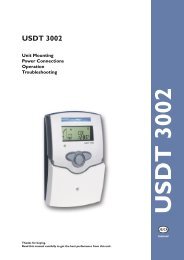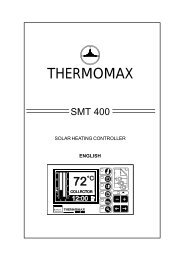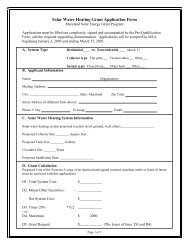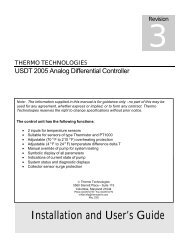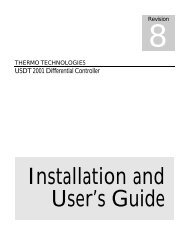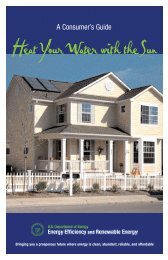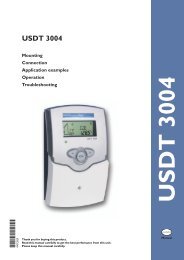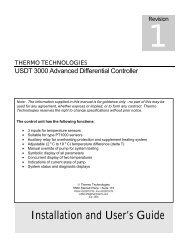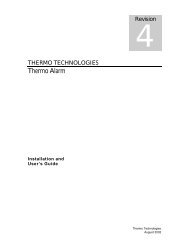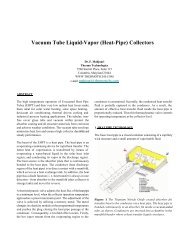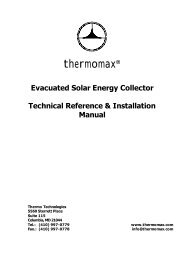USDT 2004 Differential Controller - Thermomax Technologies
USDT 2004 Differential Controller - Thermomax Technologies
USDT 2004 Differential Controller - Thermomax Technologies
Create successful ePaper yourself
Turn your PDF publications into a flip-book with our unique Google optimized e-Paper software.
CLEARClears NO CIRC display after correctionE nergy calculation - Energy gain is calculated by obtaining thetemperature increase of heat transfer fluid across the solar collector. The amountof fluid flow through the collector is registered by an in-line flow meter. <strong>USDT</strong><strong>2004</strong> computes the energy production as a function of the temperaturedifferential and fluid volume. In addition, the system anti-freeze (Glycol)percentage should be entered as it affects the thermal conductivity and heattransfer rate.BTU Energy calculation modeS IN Sensor port selection for inlet temperature (1, 2, 3, --)S OUT outlet temperature (1, 2, 3, --)F SEN Sensor port selection for flow rate (1, 2, 3, --)Energy calculation will be initiated only after temperature sensor ports aredesignated. Flow rate can be either a constant number to be entered by user, orfrom a flow meter input. To activate the energy calculation without using the flowmeter's impulse input, a dash (-) must be selected for F SEN channel followed bythe constant flow rate in gph (gallon per hour) unit.LLP Flow meter rate impulse number in liter per pulse, if flow meter isusedGAL Constant flow rate in gph instead of flow meter reading in (--)sensor modeGLYCOL Anti-freeze percentageCLEAR Sets the BTU meter's counter to zeroDIF Sensor calibrationThe output of <strong>USDT</strong> <strong>2004</strong> unit is kW for system power and kWh or MWh forcollected energy.The energy calculation dependents on flow meter accuracy, the temperaturesensors class, and their locations. The flow meter is a mechanical device and itsaccuracy fluctuates over time. Therefore, the user should calibrate the flow meterand incorporate temperature sensor tolerance.The supplied Thermistor sensor has an accuracy of ± 2 o F. The PT1000 sensoroffers a better accuracy of ± 1 o F. DIF represents the temperature differencebetween two sensors. User can increase the accuracy of reading by adjusting theDIF parameter. The energy calculation becomes accurate at temperature rangethat this reading adjustment is made.16



